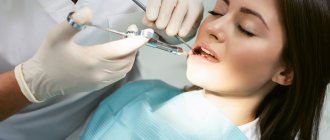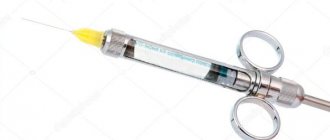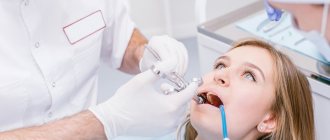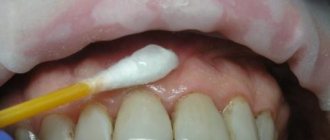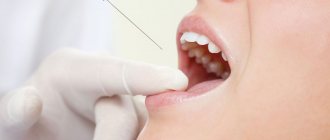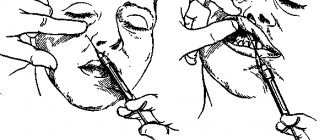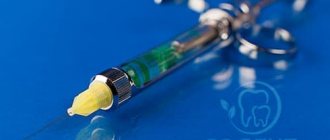What is carpule anesthesia?
Carpule anesthesia in dentistry is an injection anesthesia using a special syringe, which is called a carpule.
The use of a carpule syringe increases the safety and comfort of anesthesia.
That is, carpule anesthesia in dentistry can be of any type - the main thing is that a carpule syringe and the carpule itself with an anesthetic are used.
Equipment
Essentially, a carpule syringe is a metal dental anesthesia syringe that can be used many times and is sterilized in the same way as other dental instruments. A carpule with an anesthetic is inserted into the carpule syringe - a special glass cartridge, factory-made.
Currently, the Trilogy Medical and Dental Center uses carpule syringes for injection anesthesia - they are much more convenient and more sophisticated than conventional disposable syringes.
Advantages of carpule pain relief
The most important advantages of carpulal anesthesia can be considered:
- The exact amount of the drug in 1 ampoule is exactly 1.7 ml. Thanks to this, the doctor can count the carpules and know exactly the dosage of the administered drug.
- Complete sterility. Carpules are manufactured and sealed in a warehouse under completely sterile conditions. This way you can be sure of the quality of the injected drug.
- Less pain from the injection itself. Patients feel less pain when punctured because the needle of a carpule syringe is much thinner and more flexible than that of a regular syringe.
- It is more convenient for the doctor to control the process. The dental anesthesia carpule syringe fits very comfortably in the hand thanks to special handles and stops. Also due to the greater flexibility of the needle, it can be bent in almost any direction without fear of it breaking off.
- Elimination of errors. When using Carpules, the possibility that the doctor will administer the wrong drug or in the wrong quantity or concentration is completely eliminated. After all, with carpule anesthesia, the doctor always knows exactly what he is injecting - the name of the drug, its concentration and quantity is written on each carpule.
Advantages
Doctors note that the carpule type of anesthesia is convenient to use. It differs from other painkillers in the following advantages:
- Accuracy in dosage selection. One part of the carpool holds a volume of 1.7 ml.
- 100% sterility. This is an important point during the procedure, because the individual characteristics of the patient can provoke complications when the slightest microorganisms enter the blood.
- Minimal tissue damage. A thin needle does not cause pain and allows you to apply the drug in hard-to-reach areas.
- Ease of use. The design of the syringe is convenient for use by the dentist and provides free control. The needle is flexible and cannot break.
- Elimination of errors when choosing a drug. The carpule packaging indicates the name of the drug and dosage.
Disadvantages of carpule anesthesia
Despite the minor disadvantages described below, carpule anesthesia in dentistry is currently considered the safest and most modern option for injecting an anesthetic.
- Higher price of equipment.
Carpule syringes are more expensive per unit than disposable syringes. This is due to the fact that syringes with carpules for anesthesia in dentistry are quite complex in design, plus really high-quality ones will cost more than simpler options.
- It is impossible to change the concentration of anesthetic inside the cartridge - the cartridge is completely sealed and it is not possible to add anything inside.
Disposable Carpule Syringe
Home \ Dental materials, instruments and equipment \ Disposable carpule syringe
The carpule syringe is also called a disposable dental injector and is intended for injections under local anesthesia, subcutaneous and intramuscular injections, both in the field of dentistry and in other areas of medicine.
The AERS carpule injector ensures the safety of personnel during and after the injection procedure, due to a protective cap installed with the ability to extend onto the injection needle and fixed on the cylindrical body at the end of the injection, which eliminates the possibility of cross-infection among doctors and patients.
The injector is ready for use immediately after opening the package, which has a beneficial effect on the patient’s psycho-emotional state and increases the level of confidence in the dentist and the clinic.
Significant savings for the clinic and the dentist’s time by eliminating the procedure for preparing a reusable injector for use, as well as clear attendance tracking. How many injectors, so many patients!
AERS - Injection kit without anesthetic:
1. Easy to handle and convenient to use, ready for use immediately after opening the package; 2. Equipped with a carpule injection needle; 3. Equipped with a retractable protective cap that protects the doctor from accidental injury; 4. Has a system for blocking the reverse movement of the protective cap, making it impossible to reuse the injector; 5. The design of the injector allows for aspiration test;
Components of the AERS® kit
- The needle in a sterile protective package is screwed onto the threaded part of the injector;
- The stop ring allows for an aspiration test;
- Finger rest;
- Needle on the injector body;
- Double-edged injection needle;
- Needle in protective cap after injection.
Manufacturer: AERS, Russia
| Execution options | Price |
| Single-use injection kit AERS, needle 0.3x12 mm | 25.00 rub. |
| Single-use injection kit AERS, needle 0.3x16 mm | |
| Single-use injection kit AERS, needle 0.3x21 mm | |
| Single-use injection kit AERS, needle 0.3x25 mm | |
| Single-use injection kit AERS, needle 0.4x30 mm | |
| Single-use injection kit AERS, needle 0.4x35 mm | |
| Single-use injection kit AERS, needle 0.4x38 mm | |
| Single-use injection kit AERS, without needle |
Also purchased with this product:
- Dental materials, instruments and equipment
- Carpule needles
- Carpule syringe
Local dental anesthetics
- Articaine INIBSA
- Articaine, Articaine with adrenaline, Articaine with adrenaline forte
- Cathejell with Lidocaine
- Dental injection kit (disposable carpule syringe+carpule+needle)
- Mepivastesin
- Orabloc®, injection solution (Articaine with adrenaline)
- Primacaine adrenaline
- Septanest with Adrenaline
- Scandinibsa® 3% (Scandinibsa 3%) solution for injection (Mepivacaine)
- Ultracain DS, Ultracain DS forte
- Ubistezin forte
Conditions that local anesthetics must adhere to
In general, local anesthetics should:
- Do not cause allergies
- Have minimal toxicity to the body
- Have few side effects
- Easy to dissolve and excrete
In addition to this, anesthetic agents are required to:
- The effect is strong enough to completely anesthetize the tooth and surrounding tissues.
- Rapid numbness - no more than 5 minutes after the injection
- The numbness should last at least an hour - so that it is enough for the entire procedure, including the very last manipulations
- Anesthesia should take place no more than 2-3 hours later.
- Long-term stability of the drug itself – at least 2–3 years
Injector contents
Each doctor studies the composition of drugs used for anesthesia. The packaging of the medicine indicates the percentage content of the elements included in the drug. Each element plays an important role in the drug.
Main components of the injector:
- Anesthetic. The main part of the drug that reduces sensitivity. Most often these are Lidocaine, Prilocaine, Articaine.
- Vasoconstrictor – vasoconstrictor (adrenaline, mezaton). Necessary to enhance the effect of the anesthetic. But it is contraindicated for people with heart problems, diabetes, and the elderly.
- Antioxidants (sulfites and bisulfites). They protect the vasoconstrictor from destruction when exposed to oxygen. Due to the sulfur content they can cause allergies and intolerances. Not used for patients suffering from diseases of the respiratory system.
- Preservatives. Responsible for the safety of the drug until use.
- EDTA is a metal-binding element.
- Parabens. Maintain the sterility of the drug.
Before the anesthesia procedure, the doctor must make sure that the patient does not have a negative reaction to the elements included in the drug, otherwise there will be serious consequences for the person’s health and life.
Storage rules and periods
In order not to violate the shelf life of the drug, it is necessary to strictly follow several rules for storing capsules:
- Store in a dark place.
- Temperature range – 23-25 degrees.
- Inaccessibility to children and animals.
It is strictly prohibited to use capsules stored incorrectly.
The unsuitability of the drug can be determined by its appearance. Main features:
- Violation of the integrity of the packaging.
- Presence of sediment.
- Color change.
- The appearance of bubbles.
- Rust on the ampoule.
Requirements for drugs
Each product used for pain relief must meet the basic requirements of the dentist.
The first priority, of course, is patient safety. The medicine should not cause allergies, contain toxins, or have serious side effects.
Secondly, the doctor must be sure that the duration of exposure to the drug is sufficient to carry out the intended therapeutic actions.
Popular means
For carpule anesthesia in dentistry, drugs from French manufacturers are more often used, which meet quality characteristics and are affordable.
The most common:
- Ultracaine. It acts within a minimum period of time (1-2 minutes) after administration.
- Ubistezin. The action lasts 25-30 minutes. Suitable for children and pregnant women.
- Scandonest. Includes a large amount of adrenaline. Provides minimal bleeding.
- Septanest. Works for 15-20 minutes. More often used for people with health problems.
Reasons for the lack of pain relief
It often happens that after the administration of anesthesia, sensitivity in the area of the upcoming treatment is retained completely or partially. One of the reasons is poor quality of the drug. But there are other reasons:
- Fear that blocks reflexes.
- The production of adrenaline, which neutralizes the effect of the drug.
- Alcohol addiction.
- Accustoming the body to the drug.
Treatment technologies are developing, new developments are being created to improve the quality of dental services.
Carpule anesthesia is used in every dental clinic. Anesthesia helps make the treatment more comfortable and also reduces the patient's fear of the upcoming procedure.
The best anesthetic – does it exist?
As we said above, almost all modern anesthetics are made on the basis of articaine, so there is not such a fundamental difference between them. Most patients are anesthetized with Ultracaine or Ubestezin.
But we must also take into account that, of course, it is important what is injected, but it is also important how it is done - a lot depends on the doctor and the technique of performing anesthesia.
Indications, contraindications and consequences of carpules anesthesia depend more on the type of anesthesia - infiltration or conduction, than specifically on the carpules. But, as we noted earlier, with carpule anesthesia there is no risk of administering the wrong drug and there is virtually no risk of the needle breaking off.
